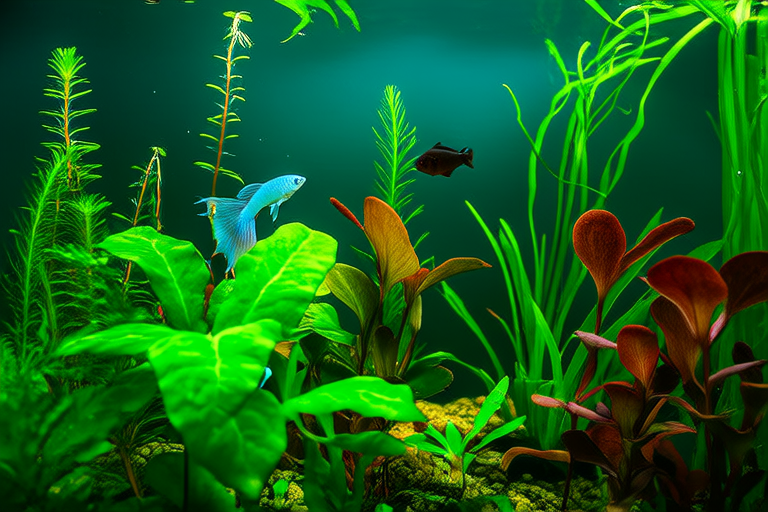Top 10 Plants for a Thriving Betta Aquarium Setup
Creating a vibrant and healthy environment for your betta fish involves more than just water quality; it’s also about providing an aesthetically pleasing and functional habitat. Aquatic plants play a crucial role in achieving this goal. They offer numerous benefits, including oxygenating the water, providing hiding spots and breeding areas, and reducing stress for your betta. Additionally, plants help in maintaining water clarity by absorbing excess nutrients that can lead to algae growth. This article will explore the top ten plants that can contribute significantly to a thriving betta aquarium setup.
1. Java Fern
Name: Microsorum pteropus
Description: The Java Fern features glossy, dark green leaves that grow in a variety of shapes and sizes. It has a robust rhizome that anchors it to surfaces within the aquarium.
Care Requirements: Java Fern prefers low to moderate lighting and can thrive in a wide range of water parameters. It should be attached to driftwood or rocks rather than planted in substrate.
Benefit for Bettas: Java Fern provides excellent hiding spots and a sense of security for bettas. Its leaves also serve as a natural decoration, enhancing the aesthetic appeal of the tank.
2. Anubias Nana
Name: Anubias nana
Description: This slow-growing plant boasts thick, heart-shaped leaves that are typically dark green. Anubias nana is known for its compact size and elegant appearance.
Care Requirements: Like Java Fern, Anubias Nana thrives in low to moderate light conditions and requires no substrate planting. It is highly adaptable to different water parameters.
Benefit for Bettas: Anubias Nana offers shelter and reduces stress for bettas. Its leaves are also beneficial for spawning bettas, as they can lay eggs on the plant.
3. Cryptocoryne Wendtii
Name: Cryptocoryne wendtii
Description: This plant comes in various leaf colors ranging from green to reddish-brown. It forms dense clusters of leaves that create a lush, natural look.
Care Requirements: Cryptocoryne Wendtii prefers moderate to high lighting and slightly acidic water. It can be planted in substrate but may require some time to adapt to new environments.
Benefit for Bettas: The dense foliage of Cryptocoryne Wendtii provides ample hiding spots and enhances water quality by absorbing nutrients. Its presence also contributes to a serene and attractive tank environment.
4. Amazon Sword
Name: Echinodorus amazonicus
Description: Amazon Swords have broad, sword-like leaves that can grow quite large, adding a dramatic element to the aquarium.
Care Requirements: These plants need strong lighting and nutrient-rich substrate. They are relatively hardy and can tolerate a range of water conditions.
Benefit for Bettas: Amazon Swords offer extensive hiding spots and their robust nature makes them less susceptible to damage from betta fin nipping.
5. Dwarf Hairgrass
Name: Eleocharis parvula
Description: Dwarf Hairgrass consists of thin, delicate blades that form a carpet-like spread across the substrate. It creates a beautiful, natural lawn effect.
Care Requirements: This plant requires bright lighting and nutrient-rich substrate. It needs regular trimming to maintain its carpet-like appearance.
Benefit for Bettas: Dwarf Hairgrass provides a safe swimming area and a place for bettas to hide. It also helps in maintaining water clarity.
6. Water Wisteria
Name: Hygrophila difformis
Description: Water Wisteria has lanceolate leaves that grow in a bushy manner. It can reach considerable heights, making it suitable for taller tanks.
Care Requirements: This fast-growing plant thrives in medium to high lighting and benefits from CO2 injection. It is relatively easy to propagate.
Benefit for Bettas: Water Wisteria offers plenty of cover and contributes to better water quality by absorbing excess nutrients.
7. Hornwort
Name: Ceratophyllum demersum
Description: Hornwort is a free-floating plant with fine, thread-like branches. It can grow rapidly and provides excellent coverage for the tank.
Care Requirements: Hornwort does not require substrate and can adapt to various lighting conditions. It is particularly effective at absorbing nitrates.
Benefit for Bettas: Hornwort serves as a natural filter, improving water quality, and provides a hiding spot for bettas.
8. Marimo Moss Ball
Name: Aegagropila linnaei
Description: Marimo Moss Balls are spherical, soft, and made up of tangled strands of filamentous green algae. They add a unique touch to any aquarium.
Care Requirements: These balls require gentle lighting and should be rotated occasionally to ensure even growth. They do not need substrate.
Benefit for Bettas: Marimo Moss Balls improve water quality and provide a visually appealing focal point in the tank.
9. Rotala Rotundifolia
Name: Rotala rotundifolia
Description: Rotala Rotundifolia has small, round leaves that grow densely along its stem, creating a bushy appearance. It can vary in color depending on lighting.
Care Requirements: This plant needs high lighting and CO2 injection for optimal growth. It can be planted in substrate or left floating.
Benefit for Bettas: Rotala Rotundifolia provides shelter and contributes to water quality improvement through nutrient absorption.
10. Vallisneria Spiralis
Name: Vallisneria spiralis
Description: Vallisneria Spiralis has long, ribbon-like leaves that can grow quite tall. It adds a vertical element to the tank.
Care Requirements: This plant prefers moderate lighting and slightly alkaline water. It should be planted in substrate.
Benefit for Bettas: Vallisneria Spiralis provides hiding spots and helps maintain water quality by absorbing nutrients.
Tips for Maintaining a Healthy Aquatic Plant Environment for Bettas
To ensure your betta aquarium remains vibrant and healthy, follow these tips:
- Provide adequate lighting according to the specific needs of your plants.
- Ensure proper water parameters, including temperature, pH levels, and hardness.
- Perform regular water changes to maintain cleanliness and prevent algae overgrowth.
- Use appropriate fertilizers and CO2 systems if necessary.
- Trim and prune plants regularly to encourage healthy growth and prevent overcrowding.
By incorporating these plants into your betta aquarium setup, you’ll not only enhance the visual appeal but also create a healthier and more comfortable living space for your betta fish. Whether you’re a beginner or an experienced aquarist, understanding the specific needs and benefits of each plant can help you build a thriving aquatic ecosystem.
